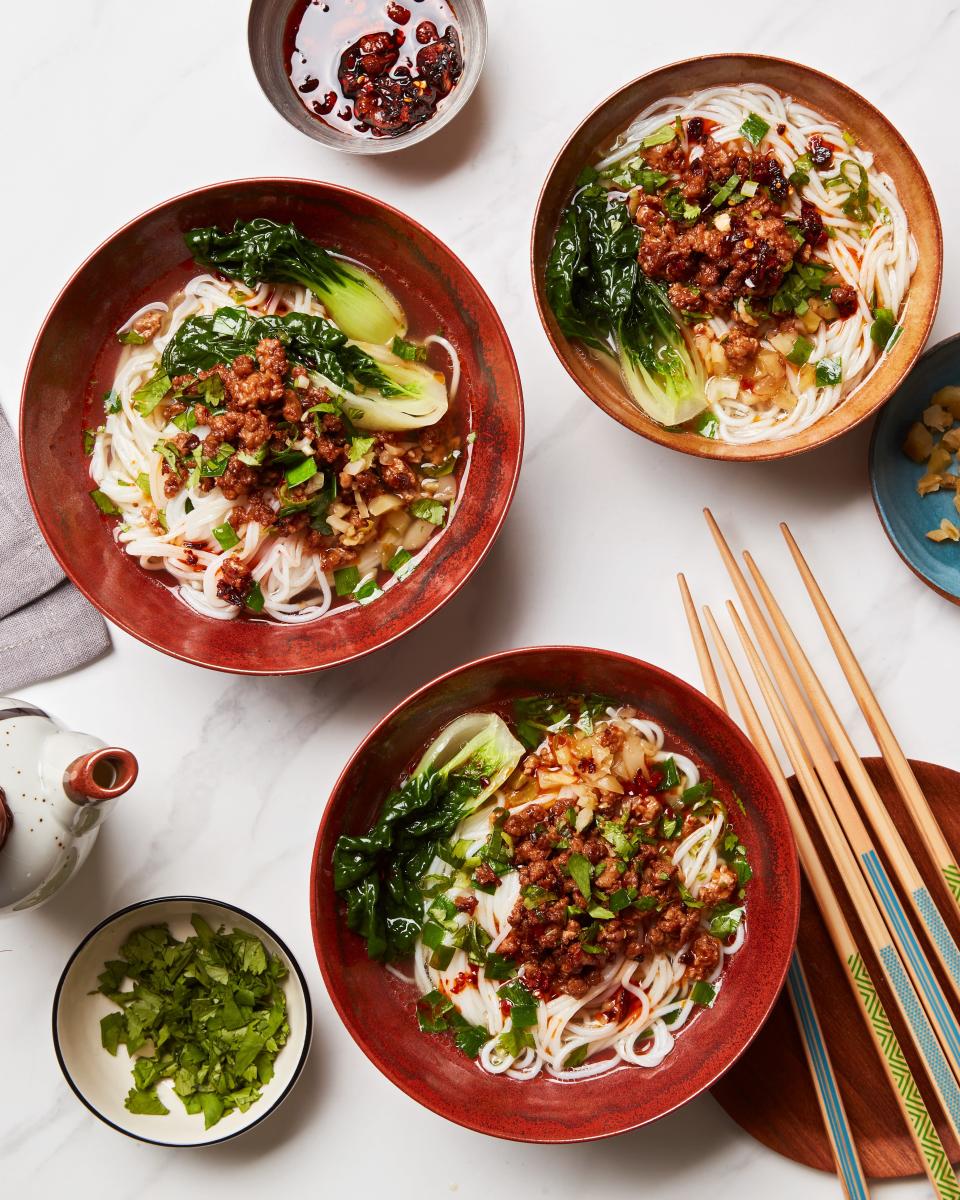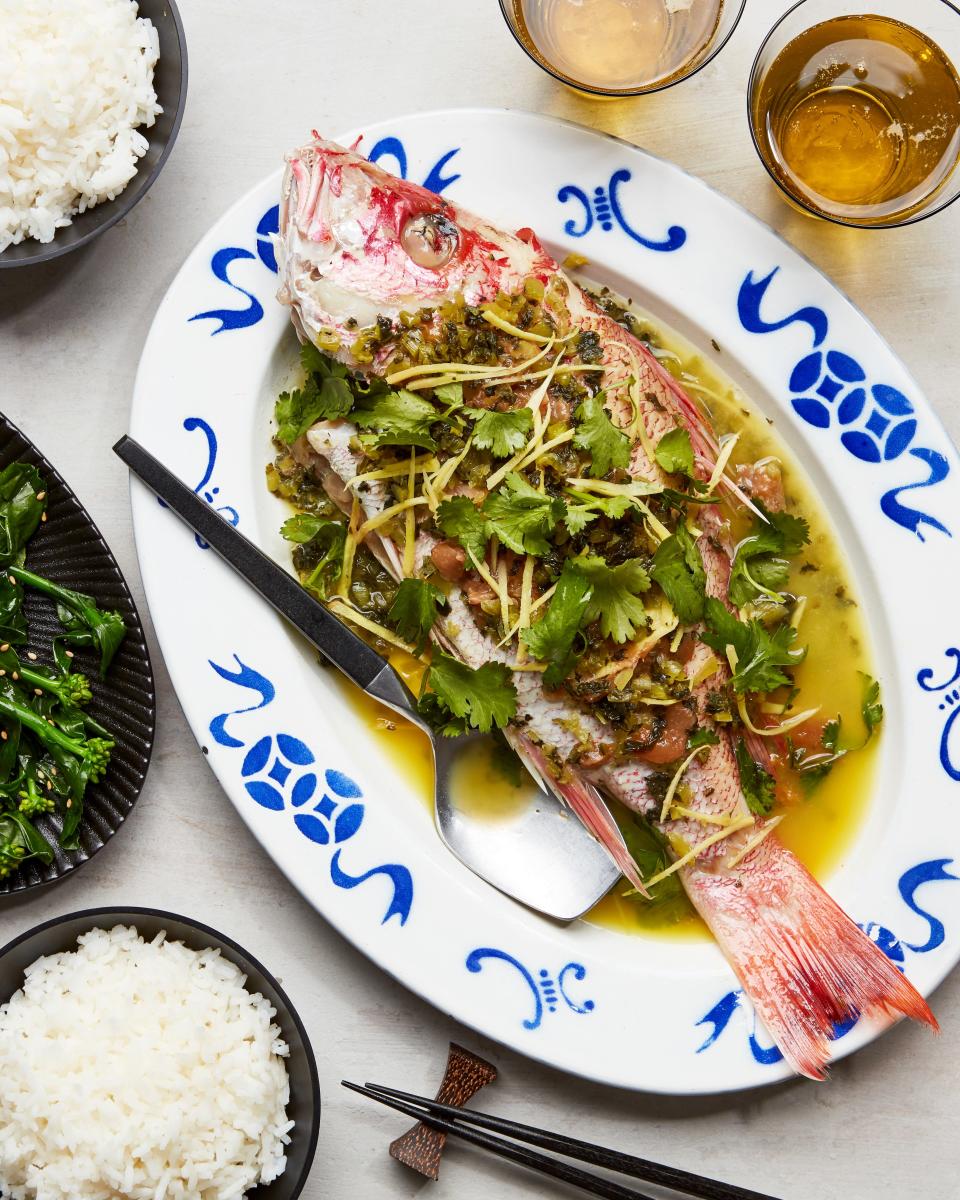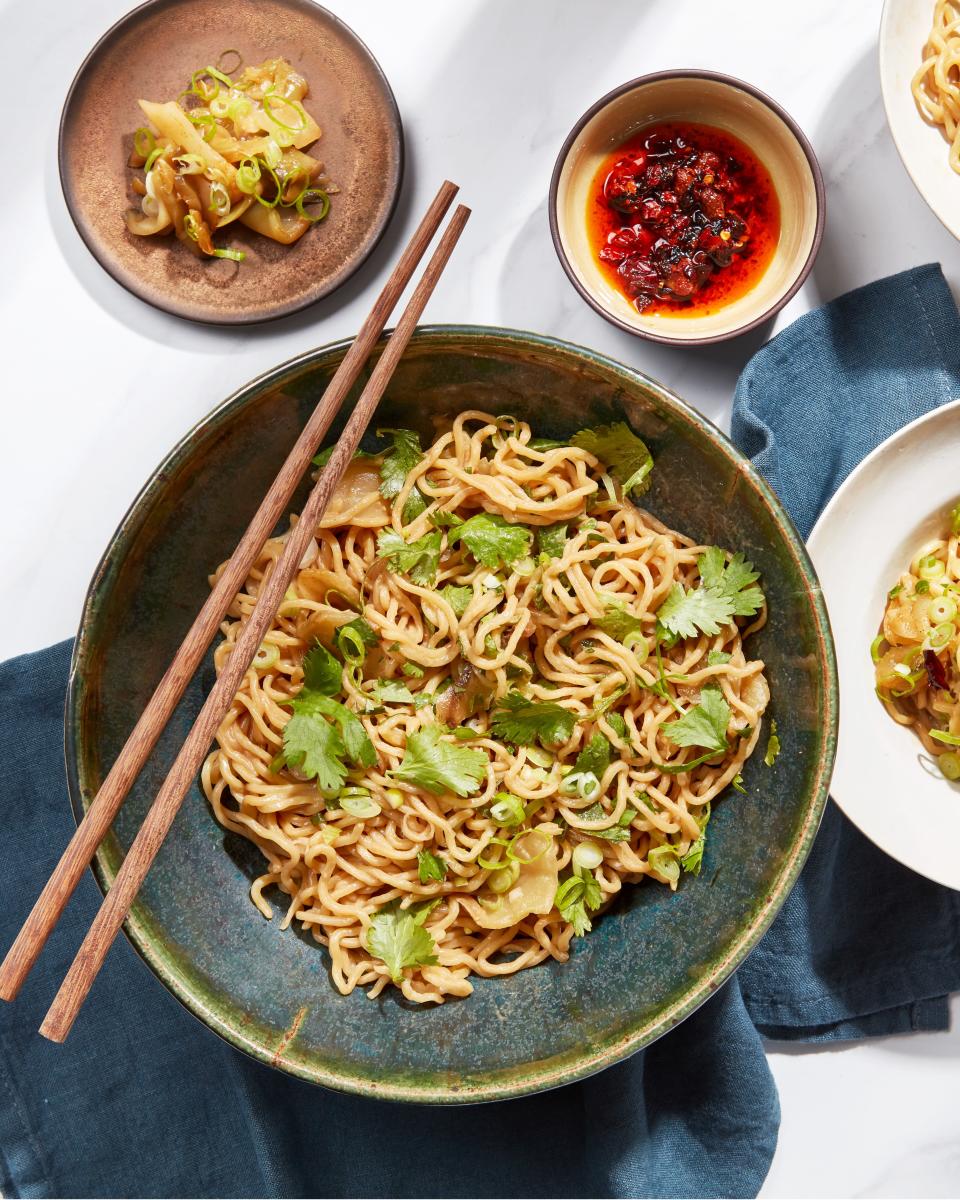When New York City chef Simone Tong was developing the menu for her Yunnan-style rice noodle cafe, she knew she could not serve a carbon copy of the rice noodles she experienced sampled for the duration of her study vacation to China.
“In China, they use no matter what they can locate in their village. When I was escalating up, we just went to the soaked current market and you just purchased whatever they provided—bok choy, garlic chives, celtuce leaves. We have this strategy named ‘yi fang shui tu yang yi fang ren,’” she states. “It’s a area that nourishes the men and women who dwell in it.”
In Kunming, the cash city of the Chinese province of Yunnan, fresh new rice noodles are shipped from factories to eating places in the early morning, speedily blanched, and plopped into a fragrant bone broth with seasonal greens. They’re then dressed with a dollop of chili oil and punctuated with housemade pickles concocted from local types of mustard greens. A pleasant equilibrium of spicy and savory, the dish is many people’s most well-liked way to jumpstart the day.
But instead of trying to only source especially Chinese greens in New York, Tong introduced the spirit of yi fang shui tu yang yi fang ren with her by incorporating local farmers industry finds into her menu, which includes contemporary pea shoots and winter radishes she pickled herself. Her noodle soups experienced all the making blocks of a traditional Yunnan breakfast, but with a unique area flair.

Like quite a few cooks, she does not use the word reliable. “When it comes to authenticity, there’s a whole lot of respect, a ton of terroir, and a large amount of elements you have to get from the locals.” Since the word usually means diverse points to all people, she states, “You can not declare to be genuine. I can declare to be delicious. I can declare to be inspired by the area.”
“Authenticity” is a loaded phrase that a lot of cooks like Tong keep absent from, due to the fact the quite concept discriminates in opposition to foods that has developed in excess of decades and generations. It indicates that food stuff needs to conform to a set of regular dishes and flavors established at an arbitrary time and put, even as new substances are launched and as communities migrate. There is an expectation that a dish should really glance and taste a precise way in buy to be valid, and the onus generally falls on the chef—not the critic—to be fantastic ambassadors of their culture’s delicacies. It’s an unrealistic typical that’s destined to are unsuccessful, simply because what is authentic to 1 man or woman might be fully unfamiliar to a further.
In the realm of Chinese delicacies, this variety of gatekeeping has left numerous Chinese cooks and food stuff writers bewildered and second-guessing the food stuff that they grew up taking in.
“When people discuss about authenticity, it is that concern of nostalgia,” claims Barbara Leung, operations supervisor of Nom Wah Tea Parlor, the oldest dim sum cafe in Manhattan’s Chinatown. “But it’s also people’s internalized prejudices, wherever they have certain expectations of factors.” Irrespective of the actuality that Nom Wah has been about for more than a century and is staffed and owned by people today of Chinese descent, Leung says that they however get accusations of not currently being genuine more than enough. “People say since we really do not have dim sum carts, it’s not genuine,” claims Leung, pointing out that even most dim sum dining places in Hong Kong do not use carts, and that the technique encourages food waste and causes food items to go cold.

“We’ve also gotten criticism for our rice noodle rolls staying also thick. But this is the way our chef masters ended up taught,” she says, pointing out that Cantonese food in the 20th century seemed a large amount unique than Cantonese food in the 21st century. “There’s practically nothing incorrect with it.”
In reality, the shifting character of Chinese dishes embodies the pretty ethos of the cuisine: that it is a celebration of time and spot. And just as the food stuff of Nom Wah is a reflection of Cantonese foodstuff in New York in excess of the program of 100 several years, so is the food of various regions in China a reflection of each individual location’s history and unique terrain. Authenticity in Chinese food—or in any culture’s delicacies for that matter—is complicated to outline simply just mainly because it encompasses so several issues.
“Chinese meals is not a monolith,“ suggests
cookbook writer (and Epi contributor) Betty Liu, who wrote a cookbook centered close to the foods of Shanghai, where her relatives is from.
She describes the meals of Shanghai as contemporary, vivid, and aromatic. “The full goal of the spices and substances that we use—like star anise, Shaoxing wine, and aromatics like ginger and scallion—is to boost the inherent flavors of our fish and other forms of proteins,” she suggests.
Teeming with freshwater fish, crustaceans, and rice paddies, Shanghai and its neighboring provinces of Jiangsu and Zhejiang are found on a historically fertile estuary—the issue the place the river meets the sea. Due to the fact of their transitional character, estuaries are 1 of the most successful ecosystems in the world. And over the hundreds of years, the cuisine has made stoic respect for the abundance of proteins that have arisen from that hub of efficiency. The recipes and procedures in the area are intended to permit the main ingredient shine.
A person beloved dish of the area is its sweet, coin-sized river prawns, coated carefully in egg white and starch, speedily deep-fried, and served with wisps of eco-friendly tea. And each individual tumble, hoards of furry mitten crabs are steamed complete, cracked open up, dipped in an earthy black vinegar, and appreciated for their creamy innards. There’s also a individual affinity for salted ducks in the location, simply because, in antiquity, ducks have been made use of on the rice paddies to support farmers weed and try to eat bugs. It is all very minimally seasoned, nevertheless terribly pleasant. “That’s why it is referred to as ‘the land of fish and rice.’ With all the crisscrossing of all the streams, there is a ton of concentrate on what can be grown in the spot and mainly because it’s so prosperous agriculturally, which is what led the cuisine to be so centered on the make that is being grown,” Liu says.
But even although Liu’s cookbook is an homage to the food items of her spouse and children, her recipes are frequently accused of not getting consultant enough of Chinese foods. The accusations she gets are generally rooted in people’s deficiency of comprehension of the nuances of the delicacies.
“People believe Chinese meals is way too salty,” she states, recalling a moment when a single of her colleagues claimed feeding on Chinese food stuff would make one’s arms bloat for the reason that of its inherently superior sodium degree. “That’s a significant misconception.”
The reality of the matter is that China is a vast place whose 1.4 billion citizens make up 18% of the world’s inhabitants, and its expansive landmass—which is approximately the measurement of the continental United States—include sections of the towering Himalayas, tropical jungles teeming with feral elephants, singing sand dunes, and craggy karst mountains. All of these distinctly various regions have one of a kind culinary traditions occasionally they are so distinctive, they may well as well be absolutely separate cuisines.

Areas like Yunnan in the south, for example, are lush with wild foliage. The province has the optimum plant range in the region and a lot of dishes are topped with an abundance of greens like fish mint or piquant chives. And as if in an try to protect the abundance, there’s a breathtaking assortment of pickles and ferments. But journey to the opposite end of the place, and you are going to discover the arid north, where by vegetables are much more scarce and foods are instead loaded in meat and potatoes. Compared with in southern China, wherever rice is the dominant carb, northerners primarily get their sustenance in the type of wheat—including elastic hand-pulled noodles, pillowy buns, and baked flatbread.
Immigration and trade from the outdoors has also performed an huge position in shaping the food society. “We have a whole lot of affect from southeast Asia,” says Diana Zheng, referring to the meals of Chaozhou, a area in the southeast province of Guangdong. Zheng, whose family is from the area, self-released a cookbook on Chaozhou delicacies when she recognized a evident absence of English-language resources on the matter. She suggests that around the generations, migrant staff from Chaozhou would shuttle again and forth from China to Southeast Asia, which influenced a wonderful fusion of flavors. “So fish sauce is employed prominently and so is satay sauce, which is various from southeast Asian satay,” she says.

Picture by Joseph De Leo, Prop Styling by Anne Eastman, Foodstuff Styling by Lillian Chou
Even though roughly 90% of China is Han Chinese, minorities in the country—who are usually missed in the wide conversation about Chinese meals and identity—have experienced an effects on the foods as effectively. Some of the country’s most notable dishes have been born from China’s Muslim communities, such as hand-pulled beef noodle soup à la the northwest city of Lanzhou and major-plate rooster from Xinjiang.
And so what is viewed as a typical breakfast in 1 area may possibly glimpse like a fully international cuisine in another.
A single, of class, could argue “authentic Chinese food” simply just refers to the dishes that the persons in China eat, or a dish that is indigenous to the region. But if which is the logic, then how do we account for the actuality that many Chinese dishes now incorporate New Environment crops like chile peppers, potatoes, corn, and tomatoes? How extended, just, does a dish or ingredient have to exist in China ahead of it is deemed “authentically Chinese”?
The obsession with authenticity indiscriminately bulldozes around any earnest tries at furthering the cuisine, when in reality, the natural beauty of the genre lies in its malleability. Dishes are continuously becoming invented and upgraded, in accordance with the instances. The meals of Hong Kong is a poignant illustration of this. A previous British colony, Hong Kong has a exclusive class of eateries known as cha chaan tengs—a type of quick-informal cafe serving warm cups of tea with evaporated milk, buttered white toasts sans crust, and macaroni in soup. Are cha chaan tengs much less authentic mainly because of their predilection for Western elements? And what transpires when Chinese chefs immigrate overseas? Does Chinese foodstuff immediately turn into less authentic the more eradicated it is from the state of China?
“Chinese dining places in the United States appear up with unique riffs all the time, these types of as the ‘Szechuan’ alligator at Trey Yuen in the vicinity of New Orleans,” suggests David R. Chan, a retired accountant who has eaten at almost 8,000 Chinese places to eat in The us and logs all of his visits in a spreadsheet. “Some nameless Chinese cafe operator will come to a decision to tweak a dish for area consumption, it becomes well-known, and other Chinese restaurant proprietors comply with go well with.”
The capacity to adapt has been the two a energy and hallmark of Chinese food—both domestically and overseas. When the 1st Chinese dining establishments in The us opened their doors in the 19th century, the early cooks utilised what was out there to them, like broccoli as an alternative of gai lan and cashews instead of walnuts. But American-Chinese grub is generally ripped aside for not currently being Chinese plenty of, regardless of the reality it was produced by Chinese individuals from China.
But the reality is that even classically properly trained Chinese cooks stray from custom, although the changes are frequently unnoticed by the general community. Peter Chang, a Virginia-based chef who is regarded a single of the leading Chinese chefs in The united states, with a dozen eating places scattered across Virginia and Maryland, is from the central Chinese province of Hubei. He’s frequently praised for his singular mastery of Sichuanese meals, but his recipes really get inspiration from Shanghai and Hunan, as perfectly.
“It was not his intention to cook just Sichuan foodstuff or have people know him as a Sichuan chef. That was just the approach of the writers and media, who acknowledged the prominence of the numbing flavors,” suggests Lydia Chang, cafe operator and Peter’s daughter. Chang details out that quite a few of the signature dishes are her parents’ whimsical creations, like deep-fried eggplant sticks and scallion pancakes molded into large bubbles.

“I imagine what we are missing listed here is that there is no just one way to cook a dish. Each and every residence will cook dinner a dish otherwise, dependent upon their condition which may well be affected by where they reside, their accessibility to substances, their possess family traditions,” states Hetty Lui McKinnon, a Chinese-Australian cookbook creator and recipe developer who claims she typically receives flak for her recipes not currently being authentic sufficient.
McKinnon suggests she when wrote a recipe for sook mei faan (corn rice), influenced by a dish her mom produced and the renditions discovered in Hong Kong. Regardless of obviously outlining its provenance in her piece, McKinnon obtained significant criticism when a picture of the dish was posted on Instagram—many of which were being authored by men and women of Chinese descent.
“Many Cantonese commenters claimed the dish was not genuine, that they had under no circumstances eaten that dish ahead of, that their grandmother under no circumstances built that dish. Quite a few insinuated that the dish had no Cantonese origins. I was pressured to defend the dish to some commenters, but I before long realized that this was a shedding battle. In addition to, how do I defend a thing that is true to me, that I actually professional?” she suggests.
Just about every dish tells a tale, and as a substitute of invalidating that story in protection of a legendary, unattainable regular, maybe the conversation can shift towards embracing the multiplicity of a culture’s cuisine, particularly a person as huge and layered as China’s. Creativity in food really should be celebrated not suppressed. This isn’t to say, even though, that anyone can set collectively a rooster salad, drizzle it with soy sauce and rice vinegar, and label it indisputably Chinese with no contextualizing it.
“For us, authenticity is actually just about our relatives recipes,” suggests Jason Wang, the owner of Xi’an Popular Foodstuff in New York. “And you know, every single household cooks differently.”
Known for its prolonged belts of hand-ripped biang biang noodles drenched in a numbing spicy sauce, Xi’an Well known Foods was one particular of the 1st Chinese dining places in the States to serve dishes from the central Chinese city of Xi’an. Since 2005, it is been heralded as a bastion of central Chinese cuisine in The us. But even Wang is hesitant to say that his family’s dishes are immediate photocopies of what is basically offered in Xi’an.
“Are you heading to locate in our restaurant the identical dishes that are cooked on the streets of Xi’an? No, you are not. But that’s not a detrimental matter. Which is a optimistic issue. We still stick to the same style profiles, like spicy, sour, and aromatic,” he says. “But of study course, there will be nuances that are various.”
Wang says that his restaurant’s signature cumin lamb noodles—which has more than the several years come to be synonymous with Xi’an in the English-speaking food stuff environment since of Xi’an Renowned Foods—does not exist in China. It is in fact a mash-up of two dishes: cumin lamb skewers and biang biang noodles, the latter of which is typically topped with a heaping of stewed pork or straight chili oil.
“I was a seriously skinny child. I did not like having, and the only thing that made me want to take in was cumin lamb. So my father set cumin lamb and noodles together—and growth,” he states.
How we outline “Chinese meals,” in the long run, really should reflect growing and evolving culinary traditions. And in numerous means, this just one dish serves as a reminder that iconic foodstuff are not born out of a militant adherence to tradition, but by means of a cook’s creative imagination in the instant, anywhere they are.
Originally Appeared on Epicurious
